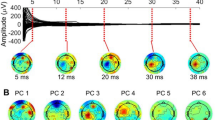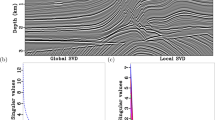Abstract
In underdetermined blind source separation (UBSS), the estimation of the mixing matrix is crucial because it directly affects the performance of UBSS. To improve the estimation accuracy, this paper proposes a joint clustering analysis method based on density based spatial clustering of applications with noise (DBSCAN) and clustering by fast search and find of density peaks (CFSFDP). In the reprocessing, the observed signals in the time domain are transformed into sparse signals in the frequency domain through a short time Fourier transform (STFT), and single-source-point (SSP) detection is used to enhance the linear clustering characteristic of signals. In addition, to facilitate the use of density-based clustering analysis, mirroring mapping is used to transform the linear clustering into compact clustering on the positive half unit circle (or sphere). For the estimation of the underdetermined mixing matrix (UMM), the DBSCAN algorithm is first used to search for high-density data points, and automatically find the number of clusters and the cluster centers; then, the CFSFDP algorithm is used to search the density peaks of the data clusters, so as to further modify the cluster centers. Because each cluster center corresponds to a column vector of the mixing matrix, the proposed algorithm can estimate the UMM through cluster analysis. The simulation results show that the proposed algorithm can not only improve the estimation accuracy of the UMM, but also provide a more robust estimator. In addition, the joint clustering method also makes up for the shortcomings of the CFSFDP algorithm that requires human intervention.












Similar content being viewed by others
References
Adalı T, Akhonda MABS, Calhoun VD (2019) ICA and IVA for data fusion: an overview and a new approach based on disjoint subspaces. IEEE Sensors Lett 3(1):7100404
Adalı T, Jutten C, Yeredor A, Cichocki A, Moreau E (2014) Source separation and applications. IEEE Signal Process Mag 31(3):16–17
Ambrois C, Dehman A, Neuvial P, Rigall G, Vialaneix N (2019) Adjacency-constrained hierarchical clustering of a band similarity matrix with application to genomics. Algorithms Mol Biol 14(22):1–14
Asaei A, Bourlard H, Taghizadeh MJ, Cevher V (2016) Computational methods for underdetermined convolutive speech localization and separation via model-based sparse component analysis. Speech Commun 76:201–217
Averbuch G, Assink JD, Smets PSM, Evers LG (2018) Extracting low signal-to-noise ratio events with the Hough transform from sparse array data. Geophysics 83(3):1–9
Bofill P, Zibulevsky M (2001) Underdetermined blind source separation using sparse representations. Signal Process 81:2353–2362
Chen Y, Li Y, Zhou J (2018) Mixing matrix estimation in underdetermined blind source separation based on single source points detection. 2018 18th IEEE International Conference on Communication Technology, Oct. 8-11, 2018, Chongqing China, pp. 1077–1081
Chen Y, Tang S, Bouguila N, Wang C, Du J, Li H (2018) A fast clustering algorithm based on pruning unnecessary distance computations in DBSCAN for high-dimensional data. Pattern Recogn 83:375–387
Chowdhury K, Chaudhuri D, Pal AK, Samal A (2019) Seed selection algorithm through K-means on optimal number of clusters. Multimedia Tools Appl 78(13):18617–18651
Comon P, Jutten C (2010) Handbook of blind source separation: independent component analysis and applications. Academic Press, Burlington
Duong TTH, Duong NQK, Nguyen PC, Nguyen CQ (2019) Gaussian modeling-based multichannel audio source separation exploiting generic source spectral model. IEEE Trans Audio Speech Lang Process 27(1):32–43
Ester M, Kriegel HP, Sander J, Xu X (1996) A density-based algorithm for discovering clusters in large spatial databases with noise. The Second International Conference on Knowledge Discovery and Data Mining, Aug. 2-4, 1996, Portland, USA, pp. 226–231
Feng F, Kowalski K (2018) Revisiting sparse ICA from a synthesis point of view: blind source separation for over and underdetermined mixtures. Signal Process 152:165–177
Feng F, Kowalski M (2019) Underdetermined reverberant blind source separation: sparse approaches for multiplicative and convolutive narrowband approximation. IEEE/ACM Trans Audio Speech Lang Process 27(2):442–456
Fevotte C, Godsill SJ (2006) A Bayesian approach for blind source separation of sparse sources. IEEE Trans Audio Speech Lang Process 14(6):2174–2188
Frey B, Dueck D (2007) Clustering by passing messages between data points. Science 315:972–976
Fu N, Peng X (2008) K-Hough underdetermined blind mixing model recovery algorithm. J Electron Meas Instrum 22(5):63–67
Georgiev P, Theis F, Cichocki A (2005) Sparse component analysis and blind source separation of underdetermined mixtures. IEEE Trans Neural Netw 16(4):992–996
Hajji Z, Aissa-El-bey A, Amis K (2018) Simplicity-based recovery of finite-alphabet signals for large-scale MIMO systems. Digit Signal Process 80:70–82
He X, He F (2020) Underdetermined mixing matrix estimation based on artificial bee colony optimization and single-source-point detection. Multimed Tools Appl 79:13061–13087
He X, He F, Cai W (2016) Underdetermined BSS based on K-means and AP clustering. Circuits Syst Signal Process 35(8):2881–2913
He X, Wang F, Cai W, Wu L (2013) Ant colony clustering algorithm for underdetermined BSS. Chinese J Electron 22(2):319–324
He Z, Xie S, Ding S, Cichocki A (2007) Convolutive blind source separation in frequency domain based on sparse representation. IEEE Trans Audio Speech Lang Process 15(5):1551–1563
Hyvarinen A, Karhunen J, Oja E (2001) Independent component analysis. John Wiley & Sons, New York
Jia M, Sun J, Bao C, Ritz C (2018) Separation of multiple speech sources by recovering sparse and non-sparse components from B-format microphone recordings. Speech Commun 96:184–196
Koldovsky Z, Tichavsky P (2019) Gradient algorithms for complex non-Gaussian independent component/vector extraction, question of convergence. IEEE Trans Signal Process 67(4):1050–1064
Li Y, Amari SI, Cichocki A, Guan C (2006) Probability estimation for recoverability analysis of blind source separation based on sparse representation. IEEE Trans Inf Theory 52(7):3139–3152
Li Y, Amari SI, Cichocki A, Ho DWC, Xie S (2006) Underdetermined blind source separation based on sparse representation. IEEE Trans Signal Process 54(2):423–437
Li Y, Yu Z, Bi N, Xu Y, Gu Z, Amari SI (2014) Sparse representation for brain signal processing. IEEE Signal Process Mag 31(3):96–106
Mirzaei S, Hamme HV, Norouzi Y (2016) Underdetermined reverberant audio source separation using Bayesian non-negative matrix factorization. Speech Commun 81:129–137
Mohimani H, Babaie-Zadeh M, Jutten C (2009) A fast approach for overcomplete sparse decomposition based on smoothed l0 norm. IEEE Trans Signal Process 57(1):289–301
Qin Z, Fan J, Liu Y, Gao Y, Li GY (2018) Sparse representation for wireless communications. IEEE Signal Process Mag 35(1):40–58
Reju VG, Koh SN, Soon IY (2009) An algorithm for mixing matrix estimation in instantaneous blind source separation. Signal Process 89:1762–1773
Rodriguez A, Laio A (2014) Clustering by fast search and find of density peaks. Science 344(6191):1492–1496
Su Q, Shen Y, Wei Y, Deng C (2017) Underdetermined blind source separation by a novel time-frequency method. Int J Electron Commun 77:43–49
Sugden P, Canagarajah N (2003) Underdetermined blind separation using learned basis function sets. Electron Lett 39(1):158–160
Sun J, Li Y, Wen J, Yan S (2016) Novel mixing matrix estimation approach in underdetermined blind source separation. Neurocomputing 173:623–632
Taseska M, Habets EAP (2018) Blind source separation of moving sources using sparsity-based source detection and tracking. IEEE Trans Audio Speech Lang Process 26(3):657–670
Theis FJ, Puntonet CG, Lang EW (2006) Median-based clustering for underdetermined blind signal processing. IEEE Signal Process Lett 13(2):96–99
Took CC, Sanei S, Chambers J, Dunne S (2006) Underdetermined blind source separation of temporomandibular joint sources. IEEE Trans Biomedical Eng 53(10):2123–2126
Vaerenbergh SV, Santamaria I (2006) A spectral clustering approach to underdetermined postnonlinear blind source separation of sparse sources. IEEE Trans Neural Netw 17(3):811–814
Xu R, Wunsch II DC (2009) Clustering. John Wiley & Sons, IEEE Press. Hoboken, New Jersey
Yang J, Guo Y, Yang Z, Xie S (2019) Under-determined convolutive blind source separation combining density-based clustering and sparse reconstruction in time-frequency domain. IEEE Trans Circuits Syst I Reg Papers 66(8):3015–3027
Zayyani H, Babaie-Zadeh M, Jutten C (2009) An iterative Bayesian algorithm for sparse component analysis in presence of noise. IEEE Trans Signal Process 57(11):4378–4390
Zhang H, Hua G, Yu L, Cai Y, Bi G (2017) Underdetermined blind separation of overlapped speech mixtures in time-frequency domain with estimated number of sources. Speech Commun 89:1–16
Zhang W, Lv J, Li X, Zhu D, Jiang X, Zhang S, Zhao Y, Guo L, Ye J, Hu D, Liu T (2019) Experimental comparisons of sparse dictionary learning and independent component analysis for brain network inference from fMRI data. IEEE Trans Biomed Eng 66(1):289–299
Zhen L, Peng D, Yi Z, Xiang Y, Chen P (2017) Underdetermined blind source separation using sparse coding. IEEE Trans Neural Netw Learn Sys 28(12):3102–3108
Zhong Y, Wang X, Zhao L, Feng R, Zhang L, Xu Y (2016) Blind spectral unmixing based on sparse component analysis for hyperspectral remote sensing imagery. ISPRS J Photogramm Remote Sens 119:49–63
Acknowledgments
This project supported by National Natural Science Foundation of China (No. 60572183).
Author information
Authors and Affiliations
Corresponding author
Additional information
Publisher’s note
Springer Nature remains neutral with regard to jurisdictional claims in published maps and institutional affiliations.
Rights and permissions
About this article
Cite this article
He, Xs., He, F. & Xu, L. Underdetermined mixing matrix estimation based on joint density-based clustering algorithms. Multimed Tools Appl 80, 8281–8308 (2021). https://doi.org/10.1007/s11042-020-10102-5
Received:
Revised:
Accepted:
Published:
Issue Date:
DOI: https://doi.org/10.1007/s11042-020-10102-5




